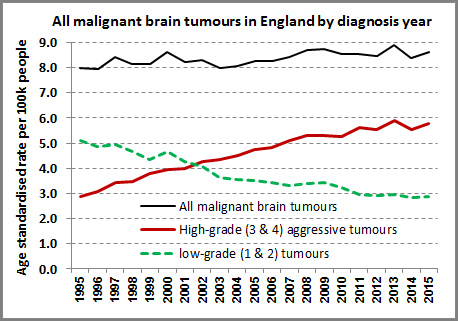Aggressive Brain Tumors on the Rise in England
Rate of GBM More Than Doubled Between 1995 and 2015
The incidence of glioblastoma multiforme (GBM), the deadliest type of brain tumor, more than doubled in England between 1995 and 2015, according to a new analysis of national statistics. During that time, the number of cases of GBM rose from 983 to 2,531.
“We found a sustained and highly significant increase in GBM throughout the 21 years and across all ages,” said Alasdair Philips, the lead author of the study, which has just been released online by the peer-reviewed, open access, Journal of Environmental and Public Health.
“The incidence rate of GBM, the most aggressive and quickly fatal brain tumor, is rising dramatically in England while the rates for lower grade tumors have decreased, masking this dramatic trend in the overall data,” Philips told Microwave News from his home in Beeswing in southern Scotland, not far from the English border.
Philips provided the graph below which shows how the total number of malignant brain tumors (black line) has remained fairly steady, concealing the increase in GBM (red line).

Source: Alasdair Philips
What’s Causing the Rise of GBM?
Philips and coworkers do not know what is causing the increase in GBM, but they reject improved diagnosis because these tumors are generally fatal and are very rarely missed. “We suggest that widespread environmental or lifestyle factors may be responsible,” they write.
One possible factor is the widespread use of cell phones.
“When we looked at the incidence of GBM tumors we found an even more dramatic rise in frontal and temporal regions of the brain. This raises the suspicion that mobile phone use may be promoting gliomas.” Philips told us (see figure below). “Indeed, our findings support previous work by Lennart Hardell’s group in Sweden.”

Source: Alasdair Philips
“The new paper adds further evidence for the increased risk of glioma associated with mobile phone use,” Hardell told us by e-mail from Örebro, Sweden. “It is in agreement with previous epidemiological findings of a higher glioma risk in humans using mobile phones and certainly also with the recent RF–animal studies from America and Italy.”
Philips also raises the possibility that an increased exposure to X-rays from CT scans might be contributing to the higher rates of GBM.
What’s Going On in the U.S.?
Increases in GBM have previously been seen in other countries, notably in the Netherlands (see our story from 2016). And there has been some anecdotal support from Denmark: In 2012, the Danish Cancer Society reported a spike in GBMs. The Society quoted a neuro-oncologist at Copenhagen University Hospital as saying that this was a “frightening development.” That news advisory was later removed from the society’s website. (See our “Something Rotten in Denmark.”)
In 2012, a group at the University of Southern California reported an increase in GBM in the frontal and temporal lobes in the U.S. But, a more recent analysis by the Central Brain Tumor Registry of the United States did not show a rise in GBM from 2000-2014 (Fig. 25). The CBTRUS study did not look at tumor location. Why there would be a difference in the incidence of GBM between England and America is not clear.
We asked David Carpenter, a neurophysiologist by training and the director of the Institute for Health and the Environment in Albany, NY, for a comment. “This appears to be the evidence that has been predicted from all the recent case-control studies showing an association between cell phone use and brain cancer,” he told us. “The question now is whether we’ll see this same trend in the American population.”
Joel Moskowitz of the Berkeley School of Public Health agrees that the issue needs more attention. “Those who cite statistics that appear to show a flat-line trend in overall brain tumor incidence and argue that cell phone use doesn’t cause brain cancer need to examine data on the location and type of brain tumors over time,” he said.
“Urgent Need for Funding”
Philips too wants more work to be done. “Our results highlight an urgent need for funding more research into the initiation and promotion of GBM tumors,” he and his coworkers argue in their new paper.
Philips is a trustee of Children with Cancer UK, a British charity. He is also the founder of PowerWatch, an activist group that has long urged precautionary policies for radiation exposure. Denis Henshaw, the second author of the new paper, is the scientific director of the cancer charity and a professor emeritus at the University of Bristol. Children with Cancer had no direct role in this study, Henshaw said.
Philips has been working on this analysis for the last seven years, without any outside funding. He himself paid for the data from the U.K. Office of National Statistics. His findings beg the question: Why didn’t anyone else, notably an epidemiologist, detect this trend in rising GBM? Henshaw commented that their findings illustrate the need to look more carefully at —and to try and explain the mechanisms behind— brain tumor trends. “You should always keep your eye out for the unexpected,” he told us.
June 25, 2018
Final version of the paper by Philips and coworkers has now been published. Available here.
They have also added a letter which argues that GBM rates may be increasing in the U.S. too.
